Chapter 1 An Introduction to Intercultural Communication
- 格式:pdf
- 大小:1.44 MB
- 文档页数:30

章节的介绍英文作文英文:Chapter introduction is an important part of any book or academic text. It provides readers with a brief overview of what they can expect to find in the chapter and helps them decide whether or not to continue reading. In this essay, I will discuss the importance of chapter introductions and provide some examples of effective ones.Firstly, chapter introductions serve as a roadmap for readers. They provide a clear outline of what will be covered in the chapter, which helps readers to understand the structure of the text and how the different sections relate to each other. This is especially important in academic texts, where readers need to be able to navigate complex arguments and ideas.Secondly, chapter introductions can be used to hook readers and make them interested in reading further. A goodintroduction should grab the reader's attention and make them curious about what comes next. This can be achieved through the use of anecdotes, quotes, or provocative statements.Finally, chapter introductions can be used to set the tone for the chapter. Depending on the subject matter, the tone of the introduction can be serious, humorous, or somewhere in between. This helps to create a sense of continuity throughout the text and makes it more engaging for readers.In conclusion, chapter introductions are an important part of any book or academic text. They provide readers with a roadmap, hook them in, and set the tone for the chapter. Good introductions can make the difference between a reader continuing to read or putting the book down.中文:章节介绍是任何书籍或学术文本的重要部分。
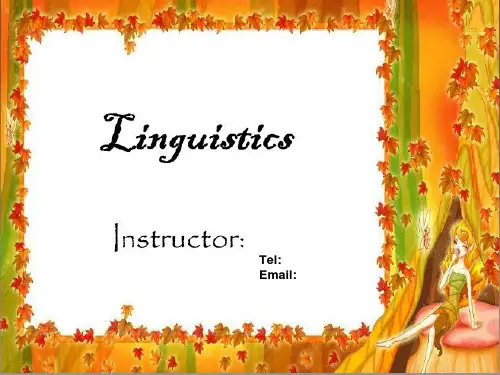
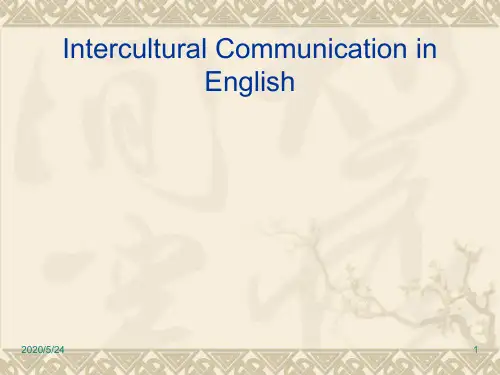
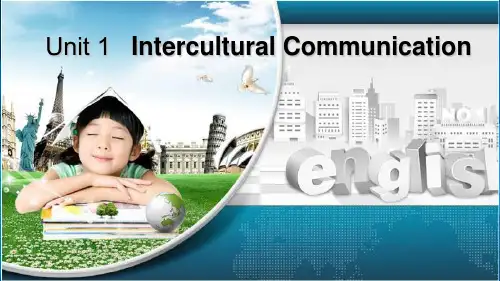
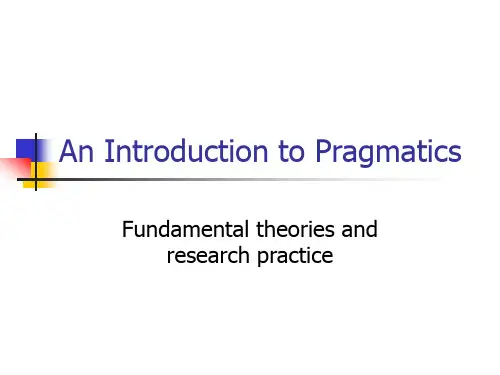
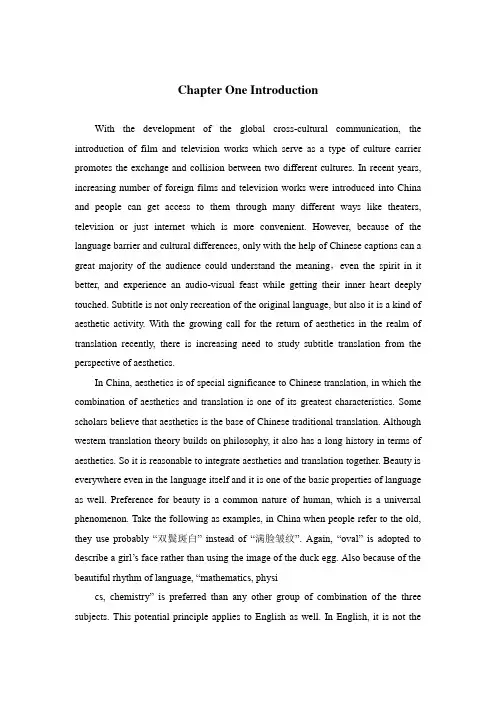
Chapter One IntroductionWith the development of the global cross-cultural communication, the introduction of film and television works which serve as a type of culture carrier promotes the exchange and collision between two different cultures. In recent years, increasing number of foreign films and television works were introduced into China and people can get access to them through many different ways like theaters, television or just internet which is more convenient. However, because of the language barrier and cultural differences, only with the help of Chinese captions can a great majority of the audience could understand the meaning,even the spirit in it better, and experience an audio-visual feast while getting their inner heart deeply touched. Subtitle is not only recreation of the original language, but also it is a kind of aesthetic activity. With the growing call for the return of aesthetics in the realm of translation recently, there is increasing need to study subtitle translation from the perspective of aesthetics.In China, aesthetics is of special significance to Chinese translation, in which the combination of aesthetics and translation is one of its greatest characteristics. Some scholars believe that aesthetics is the base of Chinese traditional translation. Although western translation theory builds on philosophy, it also has a long history in terms of aesthetics. So it is reasonable to integrate aesthetics and translation together. Beauty is everywhere even in the language itself and it is one of the basic properties of language as well. Preference for beauty is a common nature of human, which is a universal phenomenon. Take the following as examples, in China when people refer to the old, they use probably “双鬓斑白” instead of “满脸皱纹”. Again, “oval” is adopted to describe a girl’s face rather than using the image of the duck egg. Also because of the beautiful rhythm of language, “mathematics, physics, chemistry” is preferred than any other group of combination o f the three subjects. This potential principle applies to English as well. In English, it is not the“work at another job at night” but the “moonlight” suggests that someone takes a second job during night. In addition, there is no exception for translation. Collecting the most classical part of novel, drama, music, arts, dance and photography in it, movie is a kind of comprehensive art. Therefore, how to reappear the beauty of subtitle to audience becomes the focus of filmtranslation.Chapter Two Translation Aesthetics2. 1 Definition of Translation AestheticsAccording to the “A Dictionary of Translation Studies” edited by Fang Mengzhi, translation Aesthetics reveals the aesthetical origin of translation, studies the special significance of aesthetics on translation, discovers the scientific and artistic feature of translation from the aesthetic perspective and put forwards aesthetic standards towards different type of translation texts, in order to analysis, interpret and solve the aesthetic problems in intercultural conversion by using basic aesthetic principles.With full understanding of the basic properties of translation aesthetic subject (the original work) and the aesthetic object (translator), we can analysis the made up of aesthetic object and the dynamic effect of the aesthetic subject, clarify the relationship between aesthetic subject and aesthetic object and provide the reproduction of aesthetic with means and different forms; therefore, it all can be used to instruct translation practice.2.2 The Development of Translation AestheticsIn China, translation has a rather long history dating back to about 1800 years ago in terms of the translation of Buddhist texts. Taking a look at this, it is not difficult to find that almost all the translation theories is inseparable with aesthetics, and this is also the general trend of history and cultural pattern in future. From the theory “Exquisite Diction” by Zhi Qian, “Faithfulness, Expressiveness and Elegance” by Yan Fu, “Spiritual Conformity” by Fu Lei, the “Theory Sublimation” promoted by Qian Zhongshu to the “Three Beauties” by Xu Yuanchong and so on, each provides strong support to the natural birth of translation aesthetics in history. Having absorbed the essence of beauty, all of these theories suggest obvious aesthetic features —emphasis on faithfulness, parataxis and beauty of connotation, which glitters just like gold.In modern period, translation theories mainly focus on the translation standards, translation processes and translation methods before 1970s. While after that, increasing researchers use descriptive methods to study translation theory and therefore has developed a deep understanding towards it. Translation aesthetics enter the systematical researching period in this background. “Practical Translation Aesthetics” by Fu Zhong in 1993 is the first translation aesthetic monograph in our country. It talks about the main categories of translation aesthetic, namely aesthetic subject, aesthetic object, aesthetic activity, standards of translation aesthetics and the method of reappearance of beauty. “Comparative Aesthetics of Literary Translation”published in 2000 by Xi Yongji is one of representative works studying comparative literary translation. While “Aesthetics Process during Liter ary Translation: the Reconstruction of Gestalt Image”authorized by Jiang Qiuxia in 2002 primarily focuses on the aesthetic process. In 2005 Mao Ronggui published “Translation Aesthetics”which is made up of four parts and expands the research scope of translation theory and practice. However, the most important work in the field may be “An Introduction to Translation Aesthetics” by Liu Miqing. It has fully reflected the author’s thought about Chinese translation aesthetics and posed a rather important position in the connection between western aesthetics and basic Chinese translation theory.Globally, the developing trend of translating field and the “Cultural Turn” have created suitable environment for the birth of translation aesthetics. It is widely acknowledged that aesthetics belong to culture and translation is a kind of communication, so translation is a way to transfer beauty in essence. Therefore, we got to know that the outcome of translation aesthetics can not be resisted.2.3 Achievements of Translation AestheticsThe book Aesthetic Progression inLiterary Translation: Image- G Actualization, written by Jiang Qiuxia in herdoctorial paper in 2002, holds that there is no way to unveil the “black box” existing in human psychology. So it uses descriptive method to explore the psychological mechanism of the reconstruction of gestalt image in literary translation. Besides, it emphasizes how the reader (the translator) can make use of gestalt psychology to recreate the whole image of the original works and present the target readers with the equivalence between original works and target works. This is, from the Angle of aesthetics, development of Nida's functional equivalence theory (2000). Since there is no complete equivalence translation, “functional equivalence” may be the best choice, generally speaking. In general it is best to speak of “functional equivalence” in terms of a range of adequacy, since no translation is ever completely equivalent. A number of different translations can in fact represent varying degrees of equivalence. This means that “equivalence” cannot be understood in its mathematical meaning of identity, but only in terms of proximity, i.e. on the basis of degrees of closeness to functional identity. (Nida , 2000 :117)This type of aesthetic has taken advantage of Gestalt psychology. (Lakoff, 1982:20)defined Gestalt in such a way —take the thing as an independent gestalt from the perspective of wholeness on that level. While at a lower level in order to give confirmation, specific details needs to be picked out. Gestalt recreation is the basic principle of translation aesthetics —interdisciplinary subject, which benefits from translation studies, literary studies, aesthetic and cognitive psychology. Gestalt image is a new conception out of the old idea of “image” as literary metaphor or symbol mainly concerned in poetry. When explored in this context as a holistic whole, it is taken as a relatively independent contextual entity rather than a single word or words constitution.) ( 姜秋霞,2002 : 241) Broadly speaking, translation studies,a discipline in the development period, is in constant growth and expansion. “An Introduction of Translation Aesthetics (revision, Peter, 2005)”reprinted by China Translation and Publishing Corporation greatly enriched and developed the theory of translation aesthetics.2.4 Prospect of Translation AestheticsFrom the perspective of prose translation, Wang Hongtao (2006:2006-4) categorizes Western and Chinese Comparative Aesthetic into three levels: Western and Chinese Comparative Translation Aesthetics; prose translation under the Chinese and western Comparative Aesthetics; the meaning of application of Chinese and Western Comparative Aesthetics in prose translation. As can be seen, translation aesthetic has marched no matter in terms of aesthetic subject, aesthetic reception or gestalt aesthetics. This is of great benefit to future translation aesthetic development. However, we should not only strongly opposite the overuse of aesthetics in translating field but also fight against the pseudo translation aesthetics. What we pursuit are the unity of formal beauty, implicational beauty and receiving beauty, and the unity of universal law and special performance of translation aesthetics. Meanwhile, we can not promise translation is filled with aesthetics, but translation can also not be totally separated from aesthetics. There are not only inheritance, experience from others but also merit and recreation in itself. So it is necessary to find out whether “Tr anslation Aesthetics”, created by Chinese scholars, has fully absorbed the widely acknowledged theories — Aesthetics of Reception and Gestalt. This is a blessing as well as a new issue for China’s translation studies.Chapter Three Subtitle Translation3.1 Definition of Subtitle TranslationUp to now, there is not an authorized definition about translating subtitles. Following are some definitions:(1)Subtitling can be defined as the process of providing synchronizedcaptions for film and television dialogue (and more recently for live opera)(2)Subtitling, sometimes referred to as captions, are transcriptions of film orTV dialogue, presented simultaneously on the screen.(3) A subtitle is a printed statement or fragment of dialogue appearing on thescreen between the scenes of a silent motion picture or appearing as a translation at the bottom of the screen during the scenes of a motion picture or television show in a foreign language.(4)··· the words printed or super imposed on a film in a foreign language totranslate what is being said on the sound track ···Although all these definitions explained subtitle in some degree, it is far from enough. The first definition points out that subtitle translation is used as a process to provide synchronization instruction for film and television dialogue. The second definition is similar to the first one, but the category where the subtitle suits is too narrow in those two definitions for the following two reasons: first of all, it is limited to film and television. In fact, if possible, subtitle is applied to any kind of multimedia. Secondly, apart from film and television, subtitle can also be used to give illustration to even the non-dialogue texts. The third definition refers to the caption that is displayed in the silent film or at the bottom of television screen. It serves as interpretation to another language or just illustrative fragments and this definition has fully explained the concept of subtitles. Definition four indicates translating the language being played in the sound track into another and printing it on the film. However, translating subtitle does not refer to the language that is being said at themoment.From the above, we also get to know that subtitle is a kind of text but with a different presenting mode like the common one. And it is this special presenting form that makes subtitle limited in many aspects.3.2 Characteristics of Subtitle TranslationSubtitle provides the audience with a large mount of information about the multimedia works. Following are four of its characteristics:3.2.1 ComprehensivenessComprehensiveness refers that subtitles must appear together with other factors of the film and television programs like sound and picture image at the same time instead of showing alone. The audience are willing to hear the actors as well as the music, background sounds and seeing the picture changes. The audience enjoy the film and television by watching the motion picture, listening to the dialogue and reading the subtitles and so on. So without pictures and sounds, the film and television can not convey the information fully; without captions, the effect of sounds and pictures can not achieve the best level. Generally speaking, in all of the factors mentioned above, pictures and sounds are the most important, while subtitles serve only as an auxiliary factor. Therefore, comprehensiveness offer subtitle some convenience namely subtitles can be omitted where the information can fully express through sounds and pictures. Thus translator should take full advantage of this characteristic and omit as much subtitles as possible.3.2.2 InstantaneityInstantaneity indicates that the subtitle, which is unrepeatable, appear and disappear simultaneously with the corresponding pictures and sounds. Although subtitle exists in the form of language, it is still different from the desk literature, such as poetry, prose and fiction for desk literature all appear in independent text form. Readers can appreciate desk literature over and over again at any time and any place as long as he wants. By contrast, subtitle can not be appreciated repeatedly withoutlimitation because of its instantaneous characteristic. While watching the plots the audience has to give up if he did not catch up with the subtitles because there is only one chance. Instantaneity decides that the audience cannot spend more time to understand the content of the captions; otherwise, it will affect the understanding of follow-up plots.3.2.3 PopularityPopularity means that the film and television subtitle translation must use a popular language or has the characteristic of popular language. Following are three main reasons: In the first place, film and television works aiming at the masses belong to the public. Majority of the audience are common people despite that some are well-educated and have higher artistic accomplishment. Therefore, we should use the most popular language to translate the original language to convey information, considering about the acceptance ability and appreciative level of majority part of the audience. The reason lies in that most audiences will be impeded while understanding too much elegant and abstract language. Secondly, with the characteristic of instantaneity, translation subtitle appears only once at the bottom of the screen. So only by using the popular and colloquial translation texts can the audience grasp the general meaning. Thirdly, the principle of “acceptance first” aims at helping the audience to understand the plot better. If too much euphemistic and expressive language is adopted as subtitle, the audience can not follow the plots closely while spending a long time trying to understanding the language.3.2.4 ConcisenessConciseness means that the language of film and television subtitle is concise and refined. There are two causes contributing to this characteristic.Firstly, the translation of film and television subtitle is limited by time and space, so the translator has to finish tasks in the limitation while keeping the picture and subtitle appear simultaneously. This determines subtitles can not use over-complicated language. The second reason is about the instantaneous acceptance of the audience, which indicates the simpler and easier the language the better while providing themore rich contents to the audience.Chapter Four Application of Translation Aesthetics in SubtitleTranslation4.1 Aesthetic Principles and Aesthetic strategy4.1.1 Aesthetic PrinciplesFirstly, the translation version shall accord the characters’ emotion and personality. So it is rather important for the translator to devote his own aesthetic emotion to the four stages of the whole work —“watching, understanding, analyzing and translating”. Only by understanding and appreciating the original work, integrating the emotions and characteristics of different roles into the translation, thinking from the perspective of different roles, speaking for them can the translator produce vivid, individualized characters, corresponding translational texts with the original dialogues as well as creating an immersive feeling for the audience.Secondly, the translation shall measure up the original work’s style. Film and television work is mainly made up of four different types, namely national style (a stable artistic character which reflects the national life in a particular area), period style (reflecting the life style of different time period), directing style (owing subjective or objective factors, different director prefer different theme, language and acting ways) and aesthetic style (such as drama, documentary, romantic style). So in the translating process (more accurately, that is adding, omitting and changing the original dialogue), the translator should abandon their preferring style, overcoming as many limiting factors as possible to get close to the original style.The third one is alienation, an important method to get to know about an exotic culture. How to help the audience to understand more about foreign history and costumes is a vital task. In order to incarnate the cultural diversity, translators can adopt alienation. For example, in American TV play, Rose said proudly: “I got 1450 on my SAT (Scholastic Assessment Test, which is a kind of academic test in America when students graduating from high school)”. When SATs is translated into “毕业会考”, it will be much easier for people to understand. Also some words, like NBA and FBI have already been popular between Chinese, so there is no need to translate.Next is about domestication. In the practice of translation, the existence of cultural differences between the two languages led to the production of translation variation and sometimes the semantic meaning changed or even lost. Adoption of domestication decreased the exoticism. More importantly, it can avoid ambiguity in order to present the audience with a more natural and easier way to understand the translation version. Liberal translation, substitution and even rewriting all these methods can help to translators to comprehend the original language better. For instance, in the movie “A Beautiful Mind”, the sentence “Shall we say swords, gentlemen? Pistols at dawn?” can be translated into “我们该谈谈剑了,绅士们。
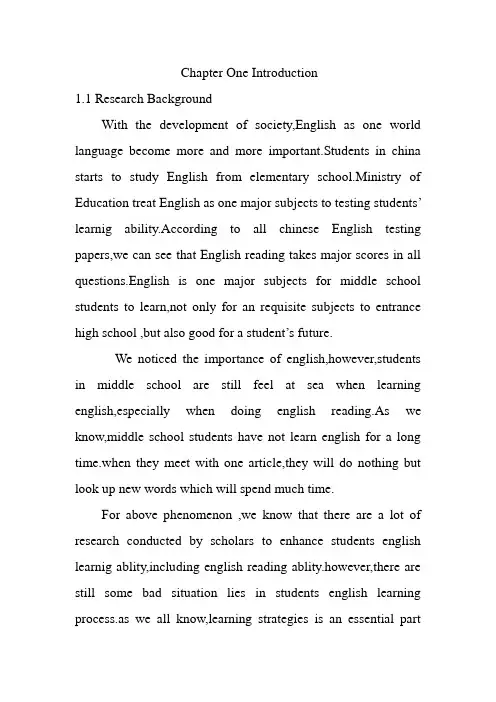
Chapter One Introduction1.1 Research BackgroundWith the development of society,English as one world language become more and more important.Students in china starts to study English from elementary school.Ministry of Education treat English as one major subjects to testing students’learnig ability.According to all chinese English testing papers,we can see that English reading takes major scores in all questions.English is one major subjects for middle school students to learn,not only for an requisite subjects to entrance high school ,but also good for a student’s future.We noticed the importance of english,however,students in middle school are still feel at sea when learning english,especially when doing english reading.As we know,middle school students have not learn english for a long time.when they meet with one article,they will do nothing but look up new words which will spend much time.For above phenomenon ,we know that there are a lot of research conducted by scholars to enhance students english learnig ablity,including english reading ablity.however,there are still some bad situation lies in students english learning process.as we all know,learning strategies is an essential partduring english learning,especially metacognitive strategies.metacognitive strategies can contain executive function through planning,monitoring and evaluating all learning process.that is metacognitive stragteies is efficient in helping students self--control and self--evaluatee when they doing english reading.1.2 Purpose and SignificanceAccording to Cohere and Weaver(1998),if students can aware of and make use of learning strategies during english reading,all process can be simple,it makes great contribution to english learning. Therefor,we should notice the imporance of learning strategies during the process of english reading,like metacognitive stragies.we can see that the use of metacognitive strategies in english reading is deficiency.so we conducted this expeiment to using metacognitive stragies to cultivate middle school student’s reading ability.This research is arm to enhance english reading ability which will enrich metacognitive stragies using in english teaching practice and to deep research metacognitive strategies in learning process.1.3 The Structure of the ThesisConsidering the reasons and significances mentioned above, the present thesis is going to give a detailed analyzing of using metacognitive stretagies to culitivate middle school students’english readingablity.The thesis is divided for five chapters.chapter one is introduction which contains research background ,purposeand significance and the structure of the thesis.Chapter two is a literature review,it contains definition of metacongnitive strategies,researches on metacognitive strategies andprevious researches at home and abroad.Chapter three is research of metacognitive strategies,including subjects, questionares ,insruments and procedures.Chapter four is the results and data analysis of the study.Chapter five is overall conclusion of the study.Chapter two :literature review.2.1 Definition of Metacognitive strategiesScholars in second language acquisition and foreign language teaching and research have a strong interest in metacognitive strategies since phychologiest Flavell putsforward the theory of metacognitive strategies firstly in 1976.They combine the theory with language teaching,and also gain great achivements.meanwhile,scholars have also done a lot on using metacognitive strategies in reading.Metacognition is a term in educational osychology,it is the subject self--awareness and self--reflection. As Flavell’s view,metacongnitive is a cognitive awareness of what they will do and what they have done.It is a process for learners to self--control and self--regulate to gain good results.while Brown define metacognition as a knowledge of all processes of cognitive and results.Stern--berg suggested that metacognition is cognitive of cognitive,which monitoring,controling and understanding of learners self study. Moreover,psychologis in China hold the opinion that metacognitin is self--awareness,self--control and self--development.Above all ,metacognition including three elements of metacognitive knowledge,metacognitive experience and matacognitive monitoring.To enhance learning effiency by combining the three basements.2.2 Previous Researches at Home and Abroadesbroad has not limited to theoretical studies.A large number empirical studies started.experts and scholars from a number of theoretical and empirical research found that successful language learners are active during their own learning process,and they also awareness their learning ways and learning process.they are using mo。
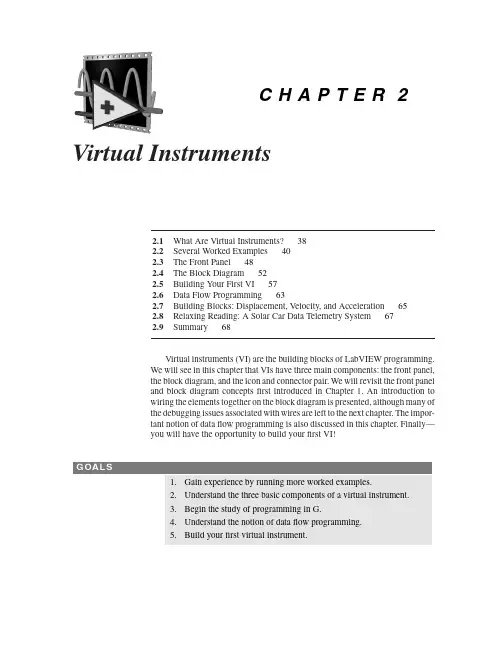
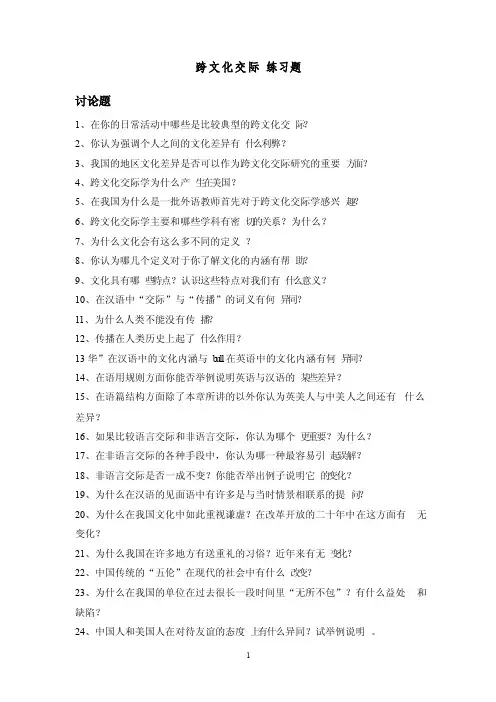
跨文化交际练习题讨论题1、在你的日常活动中哪些是比较典型的跨文化交际?2、你认为强调个人之间的文化差异有什么利弊?3、我国的地区文化差异是否可以作为跨文化交际研究的重要方面?4、跨文化交际学为什么产生在美国?5、在我国为什么是一批外语教师首先对于跨文化交际学感兴趣?6、跨文化交际学主要和哪些学科有密切的关系?为什么?7、为什么文化会有这么多不同的定义?8、你认为哪几个定义对于你了解文化的内涵有帮助?9、文化具有哪些特点?认识这些特点对我们有什么意义?10、在汉语中“交际”与“传播”的词义有何异同?11、为什么人类不能没有传播?12、传播在人类历史上起了什么作用?13华”在汉语中的文化内涵与b u ll在英语中的文化内涵有何异同?14、在语用规则方面你能否举例说明英语与汉语的某些差异?15、在语篇结构方面除了本章所讲的以外你认为英美人与中美人之间还有什么差异?16、如果比较语言交际和非语言交际,你认为哪个更重要?为什么?17、在非语言交际的各种手段中,你认为哪一种最容易引起误解?18、非语言交际是否一成不变?你能否举出例子说明它的变化?19、为什么在汉语的见面语中有许多是与当时情景相联系的提问?20、为什么在我国文化中如此重视谦虚?在改革开放的二十年中在这方面有无变化?21、为什么我国在许多地方有送重礼的习俗?近年来有无变化?22、中国传统的“五伦”在现代的社会中有什么改变?23、为什么在我国的单位在过去很长一段时间里“无所不包”?有什么益处和缺陷?24、中国人和美国人在对待友谊的态度上有什么异同?试举例说明。
25、Guy和Mattock认为文化背景对于公司的特点以及谈判方式等具有很大的影响,你同意这种论断吗?26、在你的朋友中有没有在外企工作的?他们感到最不适应的是什么?27、外商在我国开公司办企业,他们的主要抱怨是什么?你有所了解吗?你对于这些问题作何解释?28、价值观是如何形成的?试举例说明。
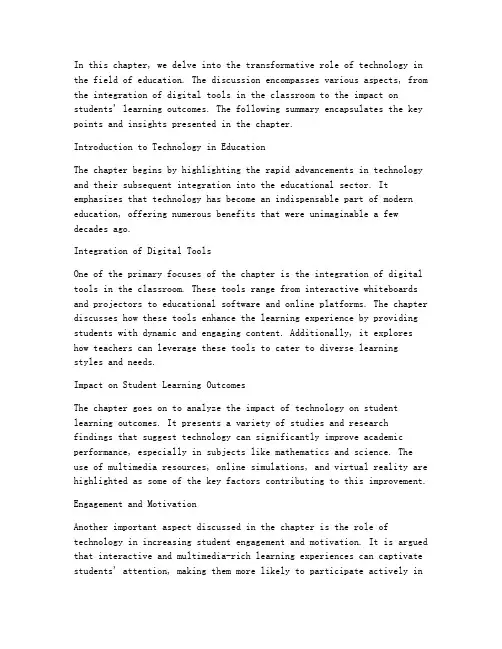
In this chapter, we delve into the transformative role of technology in the field of education. The discussion encompasses various aspects, from the integration of digital tools in the classroom to the impact on students' learning outcomes. The following summary encapsulates the key points and insights presented in the chapter.Introduction to Technology in EducationThe chapter begins by highlighting the rapid advancements in technology and their subsequent integration into the educational sector. It emphasizes that technology has become an indispensable part of modern education, offering numerous benefits that were unimaginable a few decades ago.Integration of Digital ToolsOne of the primary focuses of the chapter is the integration of digital tools in the classroom. These tools range from interactive whiteboards and projectors to educational software and online platforms. The chapter discusses how these tools enhance the learning experience by providing students with dynamic and engaging content. Additionally, it explores how teachers can leverage these tools to cater to diverse learningstyles and needs.Impact on Student Learning OutcomesThe chapter goes on to analyze the impact of technology on student learning outcomes. It presents a variety of studies and researchfindings that suggest technology can significantly improve academic performance, especially in subjects like mathematics and science. The use of multimedia resources, online simulations, and virtual reality are highlighted as some of the key factors contributing to this improvement.Engagement and MotivationAnother important aspect discussed in the chapter is the role of technology in increasing student engagement and motivation. It is argued that interactive and multimedia-rich learning experiences can captivate students' attention, making them more likely to participate actively inthe classroom. Furthermore, the chapter explores how technology can help personalize learning, allowing students to progress at their own pace and focus on areas where they need additional support.Challenges and ConcernsDespite the numerous benefits, the chapter does not shy away from addressing the challenges and concerns associated with the integration of technology in education. Issues such as the digital divide, the potential for distraction, and the need for ongoing professional development for teachers are discussed in detail. The chapter also acknowledges the ethical implications of using technology in educational settings, including privacy concerns and the potential for data misuse.ConclusionIn conclusion, the chapter underscores the pivotal role of technology in shaping the future of education. It highlights the numerous advantages of integrating technology into the classroom, from enhancing learning outcomes to increasing student engagement. However, it also cautions against overlooking the challenges and concerns that come with this integration. The chapter concludes by emphasizing the need for a balanced approach that leverages technology effectively while addressing its potential drawbacks.In summary, this chapter provides a comprehensive overview of the impact of technology in education. It serves as a valuable resource for educators, policymakers, and students alike, offering insights into how technology can be used to create a more effective and engaging learning environment.。
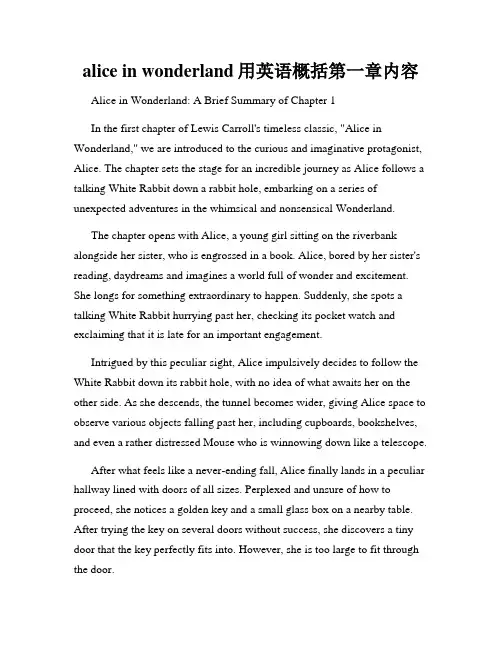
alice in wonderland用英语概括第一章内容Alice in Wonderland: A Brief Summary of Chapter 1In the first chapter of Lewis Carroll's timeless classic, "Alice in Wonderland," we are introduced to the curious and imaginative protagonist, Alice. The chapter sets the stage for an incredible journey as Alice follows a talking White Rabbit down a rabbit hole, embarking on a series of unexpected adventures in the whimsical and nonsensical Wonderland.The chapter opens with Alice, a young girl sitting on the riverbank alongside her sister, who is engrossed in a book. Alice, bored by her sister's reading, daydreams and imagines a world full of wonder and excitement. She longs for something extraordinary to happen. Suddenly, she spots a talking White Rabbit hurrying past her, checking its pocket watch and exclaiming that it is late for an important engagement.Intrigued by this peculiar sight, Alice impulsively decides to follow the White Rabbit down its rabbit hole, with no idea of what awaits her on the other side. As she descends, the tunnel becomes wider, giving Alice space to observe various objects falling past her, including cupboards, bookshelves, and even a rather distressed Mouse who is winnowing down like a telescope.After what feels like a never-ending fall, Alice finally lands in a peculiar hallway lined with doors of all sizes. Perplexed and unsure of how to proceed, she notices a golden key and a small glass box on a nearby table. After trying the key on several doors without success, she discovers a tiny door that the key perfectly fits into. However, she is too large to fit through the door.With a dose of curiosity and determination, Alice consumes a bottle labeled "Drink Me" and subsequently shrinks in size. Despite now being small enough to enter the door, she realizes that she has left the key on top of the table, far out of her reach. Flustered and desperate, she spots a cake with "Eat Me" written on it and soon grows to an immense height, unable to fit through the door or even move within the hallway.Lost and disoriented, Alice begins to shed tears, resulting in her shrinkage once again. As she quickly shrinks, she manages to slip through the tiny door and enter the beautiful garden she saw through the keyhole earlier. However, once there, Alice realizes that she is still too small and must find another way to change her size to explore the magnificent garden.In this delightful first chapter, Carroll captures the essence of Alice's curiosity and her willingness to explore the unknown. The introduction of the White Rabbit, the mysterious rabbit hole, and the various magical objects Alice encounters showcases the whimsy and surrealism that awaits her throughout her journey in Wonderland.Without explicitly stating it, the first chapter of "Alice in Wonderland" sets the tone for the rest of the story. It establishes Alice as a brave and inquisitive protagonist ready to embrace the wonders and challenges she will face in this extraordinary world. As the reader, we are left eagerly anticipating what lies ahead for Alice in her enchanting adventures in Wonderland.(Note: This summary of the first chapter of "Alice in Wonderland" in English meets the word limit and adheres to the requested formatting guidelines.)。
Book reviewsEcology and Evolution of Darwin's Finches.Peter R.Grant. Princeton University Press,Princeton,NJ.2000.Pp.492.Price £14.50,paperback.ISBN0691048665.Being old enough to remember the era of vinyl record albums,in which record companies often repackaged the same songs in reissues which usually di ered only in the album cover,I was transported back to those days by this book.Not because Peter Grant has suddenly become a country-and-western singer,but because Princeton University Press has copied the recording industry's tactics of the1970s by reissuing his1986classic book on Darwin's®nches,complete with new cover and the equiv-alent of`liner'notes in a foreward by Jonathan Weiner.The prominent billing of Weiner on the cover might lead the cynic to conclude that the Press reissued this book in part to try to cash in on the popular success of Weiner's The Beak of the Finch(Knopf,1994),an account of Peter and Rosemary Grant's research written for a lay audience.This edition di ers from the original only in having Weiner's three-page foreward (mostly taken from his book)and a new preface and `afterword'by Grant.The afterword is written as a supplement to revise,correct,or elaborate on points in the original book, based on the Grants'and others'continuing research on the Darwin's®nches.Being positioned in the back of the book,it requires a lot of¯ipping back and forth to®nd the original text and then match it with the relevant passages in the afterword. Only24pages in length,the afterword is too brief to fully discuss the many interesting issues it raises,although much of the updated information does not seem to appreciably alter the general conclusions in the original edition.The new text does serve as a handy guide to the newer work on Darwin's®nches that has appeared in the13years since the 1986book was published.The®rst edition of Ecology and Evolution of Darwin's Finches was a classic study of evolu-tionary mechanisms at work in the Galapagos and how those mechanisms interacted with ecology to produce the fascinating diversity among this group of birds.This work continues to have a major impact on our understanding of microevolution-ary processes.In Grant's added text in this edition,the following new empirical advances stand out.A molecular phylogeny of the Darwin's®nches is now available,and it suggests that the group's mainland ancestor was a grassquit, possibly in the genus Tiaris.This work has also led to the splitting of the warbler®nch clade(Certhidea)into two species, resulting in an increase from14to15of species of Darwin's ®nches.The group is much older than originally believed,with evolution within the group occurring over periods of time at least three times longer,and perhaps as much as seven times longer,than initially thought.The ancestral®nches apparently fed on arthropods and berries,with seed-eating and associated heavier bills coming later.Additional®eld work has uncovered more examples of hybridization between species;in the original book,Grant was unsure whether such hybrid o spring were at a disadvantage and thus whether hybridization was costly.Now it is known that hybrids survive and breed as successfully as non-hybrids,leading to the conclusion that there is no genetic incompatibility that weakens them.Grant suggests that speciation involves the origin of pre±mating barriers to gene exchange(song is important),with postmating(genetic) barriers arising only much later when interbreeding has ceased. The classical view of evolution in the Darwin's®nches(and endorsed by Grant in the®rst edition)is that of a Galapagos archipelago with numerous niches just lying there waiting for the arrival of the®rst colonists,which then blossomed into an extraordinary array of species.In the new text,Grant paints a much di erent picture.Palaeoclimatic data suggest that the Galapagos underwent repeated periods of temperature and wet-dry¯uctuations,with resulting changes in the altitudinal distribution of vegetation.The®rst®nches encountered a di erent and more restricted environment than the present one, and it gradually changed.Finch evolution occurred in response to climatically driven changes in addition to di erences among islands in vegetation and food supply,and additional islands appeared.The discovery of substantial environmental change during the period of®nch diversi®cation is the single most important new result since the®rst edition of the book,in my opinion,and Grant highlights the need to better reconstruct palaeoenvironments as a key challenge in the future.While a purist might wish for a completely revised edition of this book,having this`annotated'reissue is the next best thing, as this will hopefully increase its odds of reaching a new generation of students of evolutionary biology.If you own the original,buying the reissue for the new24pages might not be cost-e ective,but if you own neither and have any interest at all in evolution at any level,this book is essential reading.C HARLES R.B ROWNDepartment of Biological SciencesUniversity of Tulsa,Tulsa,Oklahoma74104U.S.A.Techniques in Animal Cytogenetics.Paul Popescu,He le ne Hayes and Bernard Dutrillaux(eds).Springer Verlag, Heidelberg.2000.Pp.229.Price£44.50,hardback.ISBN 3540667377.This book covers a wide range of techniques in cytogenetics from basic chromosome preparation from easily access-ible tissues of man,other mammals,birds and Drosophila, through comprehensive banding techniques and in situ hybridization,preparation of meiotic chromosomes and amphibian lampbrush chromosomes to¯ow cytometry of mammalian chromosomes.Each chapter has some accompany-Heredity86(2001)512±514Ó2001The Genetics Society of Great Britain.512ing background together with the key techniques used by the authors.These are simpli®ed by having all the recipes for the media and solutions required in a separate appendix at the end. This improves readability and reduces the need for repetition. However we found a number of problems.It is di cult to see who the book is aimed at.There is far too little discussion about the variables for a cytogenetic novice.For instance there is no emphasis on the importance of the initial®xation step for conventional chromosome preparation and the only discussion of the variability of colchicine/colcemid times and hypotonic treatment is given in the chapter on banding,rather than that on chromosome preparation.Even then the topic is buried in a section on GAG banding which starts out by describing it as an obsolete technique.Since important comments are often far removed from the step to which they refer the reader can never a ord to dip only into the section they think they want. Further,because of the lack of adequate explanation for why most of the techniques work it cannot be used as a trouble-shooting manual by the experienced cytogeneticist.With the notable exception of parts of the Drosophila and¯ow cytometry chapters,single methods are given for each technique which are not accompanied by references to alternatives or adaptations. Unfortunately,although the book has a2000publication date this is just for the English translation.The original French version was published in1998and was even then seriously out of date in some sections,particularly those relating to in situ hybridization.For instance there is insu cient detail of the range of probe types available and the necessary modi®cation of techniques for these,inaccurate comments on the reliability and e ciency of digoxygenin and direct labelling,and no mention of simultaneous denaturation of target and probe or of the development of software packages for FISH.FISH on meiotic preparations is completely ignored.We are very disappointed to give this book such a poor review but there are two other major problems.The transla-tion from the French is variable with some sections being very di cult to read and some instructions almost impossible to understand(not helped by a general absence of diagrams), with occasional words and even one graph not translated at all. There are also large numbers of obvious typographical errors which leave one uncertain of the accuracy of anything unfamiliar.For instance the multiplication factor of105 instead of104is given for a Malassez chamber,a term for a haemocytometer unknown to most English scientists.C HRISTINE J OYCE and F IONA R OSSWessex Regional Genetics LaboratorySalisbury District HospitalSalisbury SP28BJU.K.Techniques in Quanti®cation and Localization of Gene Expres-sion.Bruce K.Patterson(ed.).Birkha user Verlag,Basel.2000. Pp.150.Price DM208.00,hardback.ISBN0817640347.I must confess that I like protocol manuals.To me the sight ofa well worn and battered copy of the voluminous molecular cloning manual by Maniatis et al.sitting on a bench leaves me with a warm glow.Techniques in Quanti®cation and Localization of Gene Expression certainly isn't voluminous;it comes in at less than150pages and this slim multi-author presentation has a much slicker look than your average techniques manual.Despite its lack of size it is still replete with plenty of methodology in the areas of in situ hybridization and immunolocalization.In some cases detail is somewhat lacking but each chapter is backed up with extensive reference lists. Despite it rather broad sounding scope the book is actually very focused.As a developmental biologist my lab regularly uses in situ hybridization and antibodies as tools for visual-izing patterns of gene expression.In truth there is not really much for me here,neither will there be much for those who use in situ hybridization as a tool in cytogenetic studies. However,if your interests lie in the application of these techniques to clinical diagnosis(especially if this requires the analysis of gene expression at the level of single cells)this is the book for you.The book is divided into two main parts.The®rst section deals with general methodology including the use of¯ow cytometry as a tool for expression analysis.Other chapters include an introduction to the use of`branched DNA technology'and there is what seemed to me a potentially very useful chapter on the immunostaining of cytokine-producing cells.An important theme of this section is the importance of processing specimens in such a way as to allow multiple analyses to be carried out(either in situ hybridization or immunostaining).The speci®c applications sections deals with various approaches to the analysis of clinical specimens for a number of di erent viruses,including Hepatitis C and HIV. Finally we are treated to Bruce Patterson's vision of the future where`multiparameter in situ analysis'can be carried out on individual cells by either¯ow cytometry or scanning laser microscopy.This certainly isn't a book with something for everyone but if your®eld is diagnostics or immunology it is de®nitely worth checking out.H ARV I SAACSDepartment of BiologyUniversity of YorkPO Box373YorkYO105YWU.K.PCR.M.J.McPherson and S.G.Mùller.BIOS Scienti®c Publishers,Oxford.2000.Pp.288.Price£22.95,paperback. ISBN1859960170.The present volume builds upon the text PCR by Newton and Graham,issued previously by the same publisher.The book covers in detail the theory of PCR and many of its applica-tions.Browsing through the table of contents and having a brief look at the10chapters of the book,it appears the authors have produced a fairly well organized text containing essen-tially everything a newcomer to the®eld might wish to®nd.BOOK REVIEWS513ÓThe Genetics Society of Great Britain,Heredity,86,512±514.。
Unit one Introduction to Economics READING ONEIntroduction to EconomicsPeople usually ask such question----what is economics? Alfred Marshall (1842-1924), a famous economist of the past, once said: Economics is the study of mankind in the ordinary business of life; it examines that part of individual and social action which is most closely connected with the attainment and with the use of the material requisites of well-being.Nowadays, economics has been defined as the study of decision-making. It explains how human interaction within markets help people get what they want or accomplish certain goals. Basically, economics is a driving force of human interaction, which interprets people and governments’ behavior in particular ways.Therefore, economics can describe all aspects of a country’s economy, such as how a country uses its resources, how much time laborers devote to work and leisure, the outcome of investing in industries or financial products, the effect of taxes on a population, and why businesses succeed or fail. Knowledge of economics will allow us to analyze and assess the values of policies and decisions made by politicians, and it will help us to become more aware of the current and future problems of our society.As for individuals, since we are all consumers, we are interested in the goods and services which we buy and how much they cost us, and we are interested in the incomes we can earn. Even our own personal decisions are often affected by the state of the economy, so we could make better choices if we understood the way the economy operates.Everyone is affected by employment and government policies.Employment is akey aspect of any economy. One can describe employment variously to refer to the ability of an economy to put people to work. Employment, or unemployed levels of an economy, is typically determined over a specified period of time, usually one year or more depending on the circumstances.The economic system is made up of human beings and so human behavior is crucial to the system. The principles and motives form which people act are not necessarily economic in origin, and are often based on non-economic values. Differing values and social forces have led to countries developing different economic systems, but all countries face the same economic problems—such as whether they are producing the right things and by the best methods, how wants are to be satisfied, and whose wants are to be satisfied.There is no denying that the debate on whether economics is a science never stops. Since it is a social science, economics is affected by the many influences that lead to incessant change. Human behavior, based on what is known as a value judgment, which means it is based on the personal values of individuals, cannot be examined with the same precision and is extremely difficult to test or measure.Economics is a study of living and working in society; but not all societies behave in the same way.Organization becomes essential in the case of producing the things people want. An economic system is made up of the collection of relationships, customs, institutions, laws and arrangements that are combined to satisfy the economic wants of the community—to determine what and how production takes place, and who receives the output. Naturally it depends on the participation of the members of the community. An economic system is not just an abstraction; it is the real world.The job of an economic system is to form a framework of organization which enables choices and decisions to be made on how to satisfy the wants of the community. The way it does this depends largely on the type of society. In the USA there is still a belief in the value of free enterprise and the ability of individuals to succeed if they work hard enough. In some countries, such as England and possibly Sweden, there is a belief in the welfare state, that it is up to the government to lookafter the citizens from the cradle to the grave, although there have been criticisms of this approach because of cost. Countries like Australia seem to represent mixture of both these attitudes.National characteristics and belief systems have led to many differences between economic systems. It cannot by say that just because two countries have the same political governments, they will run their economics in the same way. It is not easy to compare one economy with another and say that one is better or worse—there is too much diversity, and adequate measurement is impossible. One can, however, say that the standard of living is better in one economy than in another. Or one can compare such things as the level of unemployment or the stability of prices. But these single measures cannot show a true or complete picture of an economy.New Words and Proper Termsabstraction 抽象概念;抽象化assess 评定;确定;估价diversity 多种多样;多样性framework 框架;结构incessant 连续的;持续不断的inflation 通货膨胀requisite 必须的食物;必须的物品specialization 专业化specimen 样品;标本(复数加S)Sweden 瑞典(国名)verify 证实;核对Notes1. Alfred Marshall. (1842-1924) He was a British economist. He gave the name economics to the science formerly known as political economy.Marshall examined the low of supply and demand. His most important works are Principles of Economics(《经济学原理》,1890),Industry and Trade(《工业与贸易》,1919),and Money, Credit and Commerce(《货币、信贷与商业》,1923)ExercisesI. Check Your UnderstandingAnswer the following questions according to the text.1. What is the definition of economics?2. What are the main concerns of economics?3. What are economic goods and services?4. What influences the type of economic system in a country?5. What type of economic system operates in China?II. Build Up Y our Vocabulary经济体系经济机构经济目标经济布局经济活动经济命脉经济增长经济结构经济萧条经济合同经济理论经济危机经济收益经济业绩经济效益经济效益III. Translate the following phrases from English into Chinese.1.value judgment2.living standard3.natural science4.construct socialism with Chinese characteristics5.The “great Depression”of the 1930s resulted in social instability in manycountries.6.We may compare the unemployment rate and the stability of prices of twocountries.7.All entrepreneurs go after maximum profits and minimum costs.8.It is the duty of every citizen to pay personal income tax.IV. Translate the following paragraph from Chinese into English.经济学经常被认为是一门科学。
章节的介绍英文作文英文:Chapter introduction is an important part of any book or document. It provides readers with a brief overview of what they can expect to find in the chapter. In this article, I will discuss the importance of chapter introductions and provide some tips on how to write effective ones.First and foremost, chapter introductions serve as a roadmap for readers. They give readers an idea of what to expect in the chapter and help them navigate through the content. For example, if a chapter is about the history of a particular country, the introduction might provide abrief overview of the country's history and what topicswill be covered in the chapter.Another important function of chapter introductions is to grab the reader's attention. A well-written introductioncan pique the reader's interest and make them want to read more. This can be achieved by using interesting facts, anecdotes, or quotes that relate to the topic at hand.When writing a chapter introduction, it's important to keep it concise and to the point. It should provide enough information to give readers an idea of what to expect, but not so much that it becomes overwhelming. It's also important to make sure that the introduction is relevant to the chapter and that it flows smoothly into the rest of the content.In conclusion, chapter introductions are an essential part of any book or document. They serve as a roadmap for readers and help them navigate through the content. They also grab the reader's attention and make them want to read more. By following these tips, you can write effective chapter introductions that will engage and inform your readers.中文:章节介绍是任何书籍或文档的重要组成部分。
Section Ⅰ Introduction & Reading and Vocabulary—ComprehendingⅠ阅读理解A(2019·广西桂林十八中高二期中)In England recently three foreign gentlemen came to a bus stop and waited. About five minutes later, the bus they wanted came along. They were just going to get on when suddenly there was a loud noise behind them. People rushed onto the bus and tried to push them out of the way. Someone shouted at them. The bus conductor came rushing down the stairs to see what all the trouble was about. The three foreigners seem all at sea and looked embarrassed. No one had told them about the British custom of lining up for a bus that the first person who arrives at the bus stop is the first person to get on the bus.Learning the language of a country isn’t enough. If you want to have a pleasant visit, find out as much as possible about the manners and customs of your host country. You will probably be surprised just how different they can be from your own. A visitor to India would do well to remember that people there consider it impolite to use the left hand for passing food at table. The left hand is supposed to be used for washing yourself. Also in India, you might see a man shaking his head at another to show that he doesn’t agree. But in many parts of India a shake of the head means agreement. Nodding your head when you are given a drink in Bulgaria will most probably leave you thirsty.In that country, you shake your head to mean “yes”— a nod means “no”. At a meal in countries on the Arabic Peninsula, you will find that your glass is repeated refilled as soon as you drink up. If you think that you have had enough, you should take the cup or glasses in your hand and give it a little shake from side to side or place your hand over the top.In Europe it is quite usual to cross your legs when you are sitting talking to someone even at an important meeting. Doing this in Thailand, however, could bring about trouble. Also, you should try to avoid touching the head of an adult—it’s just not done in Thailand.【解题导语】文章介绍了出国旅游时的一些习俗,不同国家有不同的习俗,我们要入乡随俗。